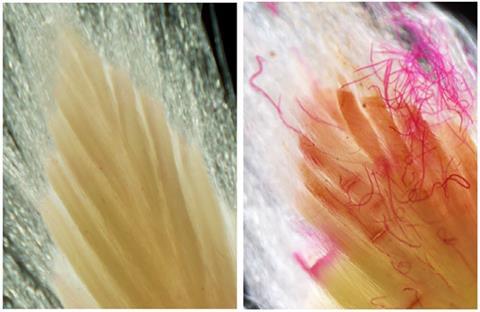Tiny worms are already causing havoc among beech in North-America. New research shows that also European beech is susceptible to this invasive pest, raising concerns for the health of European forests.
A beautiful picture, depicting a serious threat. What we see here are leaves of European beech, the one on the right being affected by nematodes, microscopic worms that cause the feared beech leave disease (BLD). This fast spreading disease is already devastating American beech across eastern North America.

Researchers from the Holden Arboretum in Kirkland, Ohio —one of the largest public gardens in the US — teamed up with the USDA Agricultural Research Services to reveal that also European beech (Fagus sylvatica) is susceptible to BLD. To date, BLD has not been reported in Europe, but this study, published in Plant Pathology, raises concerns what could happen when BLD is spreading globally. European beech is a cornerstone of native forests in Europe. BLD therforefore poses a threat to the health of forests across the continent.

Lead author Mary Pitts and colleagues used scanning electron microscopy to study how the nematodes manage to invade beech leaves and how that infestation develops into full-blown, visible disease symptoms. ’This is the first in-depth cellular-level evidence that European beech is susceptible to beech leave disease’, Pitt comments in the paper’s accompanying press release. ’We found clear signs of infection and structural damage in both the buds and leaves, similar to what we see in American beech.’ The team hopes that their insights will help tree health experts to better understand how BLD weakens the trees from inside out.
“This study helps us understand how the disease works in different beech species, which is key for understanding the basic biology of this disease and potentially help managing its spread,” says Paulo Vieira, researcher with the USDA-ARS (Beltsville, MD) and senior author on the study.
Mary Colbert-Pitts, et al, Cellular dynamics of beech leave disease on Fagus sylvatica, Plant Pathology (2025), doi:10.1111/ppa.14101













Nog geen opmerkingen